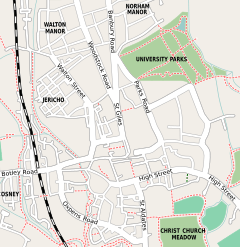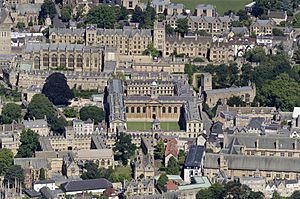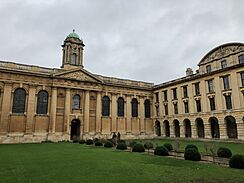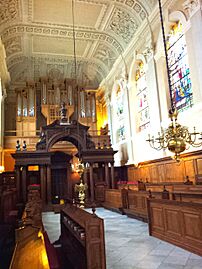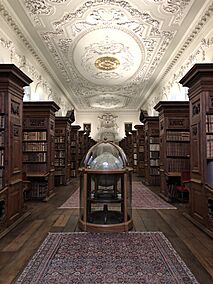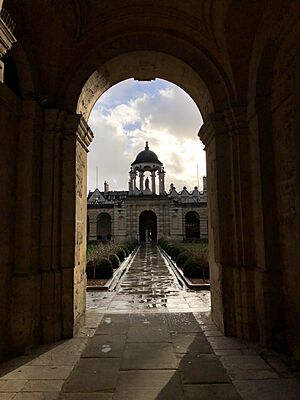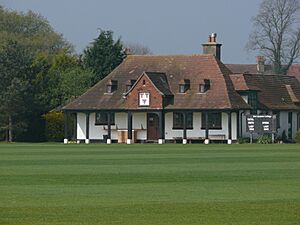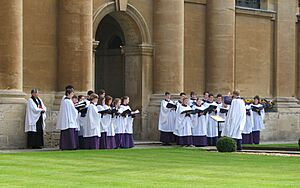The Queen's College, Oxford facts for kids
Quick facts for kids The Queen's College |
|||||||||||||
|---|---|---|---|---|---|---|---|---|---|---|---|---|---|
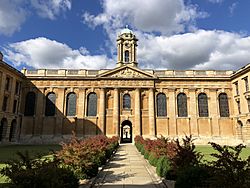 |
|||||||||||||
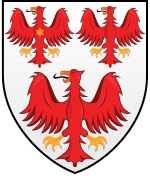
Blazon: Argent, three eagles displayed gules, beaked and legged or, on the breast of the first, a mullet of six points of the last.
|
|||||||||||||
|
|
|||||||||||||
| University | Oxford | ||||||||||||
| Location | High Street, Oxford | ||||||||||||
| Coordinates | 51°45′12″N 01°15′04″W / 51.75333°N 1.25111°W | ||||||||||||
| Full name | The Queen's College in the University of Oxford | ||||||||||||
| Latin name | Collegium Reginae | ||||||||||||
| Motto | Reginae erunt nutrices tuae | ||||||||||||
| Established | 1341 | ||||||||||||
| Named for | Philippa of Hainault | ||||||||||||
| Sister college | Pembroke College, Cambridge | ||||||||||||
| Provost | Claire Craig | ||||||||||||
| Undergraduates | 343 (2019–20) | ||||||||||||
| Postgraduates | 173 | ||||||||||||
| Map | |||||||||||||
The Queen's College is one of the many colleges that make up the famous University of Oxford in England. It was started in 1341 by a man named Robert de Eglesfield. He named it to honor Philippa of Hainault, who was the Queen of England at that time. The college is known for its beautiful buildings, which mostly have a neoclassical style from the 1700s.
In 2018, the college had a lot of money, about £291 million. This made it the fourth richest college at Oxford.
Contents
A Look Back: The College's History
The Queen's College began in 1341. It was first called "Hall of the Queen's scholars of Oxford." Its founder, Robert de Eglesfield, was a chaplain (a type of priest) to Queen Philippa. He wanted to help train clergymen from his home areas of Cumberland and Westmorland. He also wanted the college to help poor people.
The college's special shield, or coat of arms, comes from Robert de Eglesfield's family. It has three red eagles. He had big dreams for the college, wanting many students and teachers. But at first, it only had two teachers because there wasn't enough money.
Over time, the college got more land and support. By the late 1400s, it had 10 teachers. Around 1500, it started taking students who paid for their education. These were often sons of wealthy families. By 1612, there were 194 such students! The college also began teaching Greek and philosophy.
In 1585, a leader named Henry Robinson helped make the college officially "The Queen's College." Because of his work, he is sometimes called the college's "second founder."
The college became very well-known and grew until the 1750s. A former student, Joseph Williamson, became a powerful government official. He gave money to build new parts of the college. Later, a new library was built between 1693 and 1696. More money from Williamson helped build the grand front of the college that you see today. This was finished by 1759. Many gifts helped pay for these buildings and brought more students, especially from northern towns.
Like other Oxford colleges, Queen's changed over the years. In the mid-1800s, rules were updated. For example, teachers no longer had to be unmarried. Also, in 1871, a new law allowed students who were not part of the Church of England to join.
A big change happened in 1979. After more than 600 years of only having male students, Queen's College welcomed its first female students.
Why is it called "The Queen's College"?
The college is named after its first supporter, Queen Philippa. It was officially named "The Queen's College" in 1585 to avoid confusion. Even though the full name includes "The," people often just say "Queen's College."
Another college, Queens' College, Cambridge, has a different spelling ("Queens'") and no "The." This is because it was named for two queens, not just one!
Fun Traditions
One of the college's most famous events is the Boar's Head Gaudy. This was originally a Christmas dinner for students who couldn't go home for the holidays. Now, it's a special feast for former students that happens just before Christmas.
Exploring the College Buildings
The Front Quad
When you enter the college from High Street, you step into the Front Quad. This main courtyard was built between 1709 and 1759. On either side are matching buildings. At the back, you'll find the chapel and the main dining hall.
A famous architect named Nicholas Hawksmoor helped design these buildings. Above the college entrance, there's a statue of Queen Caroline of Ansbach.
The Back Quad
Behind the main hall and chapel is another, older courtyard called the Back Quad. The library is on one side. The other side has the Williamson building, which was first designed by the famous architect Christopher Wren.
The Chapel
The college chapel is known for its special organ, built by Frobenius, which was put in place in 1965. The Chapel Choir is considered one of Oxford's best mixed-voice choirs. They perform concerts each term, singing famous pieces like Handel's Messiah. The chapel has looked almost the same since it was opened in 1719.
Services are held regularly in the chapel. These include Holy Communion on Sunday mornings and Choral Evensong on Sunday, Wednesday, and Friday evenings.
The Library
The Upper Library
The Upper Library has been a very important part of the college since it was built in the late 1600s. It's a quiet place for students to read and study.
Old Globes and an Orrery
In the middle of the Upper Library, you can see two old globes made of papier-mâché from the 1700s. There's also an orrery from the same time. An orrery is a mechanical model that shows how the planets move around the sun. These globes were made by John Senex, a famous globe maker.
The orrery was given to the college in 1763. It's made of brass, steel, and wood. It shows the sun, Earth, Moon, and Mars, with places to add Jupiter and Saturn. Turning the orrery is a special event at Queen's. It's only done by hand every few years or for special occasions. Only two people are allowed to turn it: the college's Patroness (a role recently held by the Queen Mother) and the Sedleian Professor of Natural Philosophy.
Other Library Areas
The space below the Upper Library was turned into the Lower Library in the 1800s. This is where most of the books that students can borrow are kept. There are about 50,000 books here.
In 2017, a New Library opened under the Provost's Garden. It was officially opened by famous actor and former student Rowan Atkinson.
Student Housing (Annexes)
Queen's College can house all its undergraduate students. Some live in the main college buildings, and others live in nearby annexes.
- Carrodus Quad is right next to the college. It has about 80 rooms, mostly for first-year students. It also has a conference room, a music practice room, and the college gym.
- The Cardo Building is a bit further away. It houses second and third-year students. It has a common room, a breakfast room, and two squash courts.
- The James Street Building is the smallest annexe, with 12 rooms.
The Florey Building, designed by James Stirling, used to house many first-year students. However, it is no longer used for housing. After it closed, St Aldate's House became the largest undergraduate annexe. It has 90 rooms and shared kitchens.
For postgraduate students, there are two annexes: Oxley-Wright House and part of the Venneit Close complex. These offer different types of rooms and apartments. Both are a short walk from the city center.
Student Life at Queen's
Queen's College is a lively place. Students do well in sports, have many clubs, and host big parties called Commemoration Balls every three years. The 2007 ball celebrated the college's 666th anniversary!
Students can join many different groups, including dining clubs, sports teams, and academic societies like a medical society.
Student Common Rooms
- The Junior Common Room (JCR) is the group of all undergraduate students. It also refers to a special room in the Back Quad where they can relax. The JCR has a committee that helps organize events.
- The Middle Common Room (MCR) is for postgraduate students. Like the JCR, the MCR has a team that plans activities and represents the students.
- The Old Taberdar's Room is a unique room at Queen's. It's a traditional wood-paneled room with comfy sofas. It's open to all college members for relaxing or holding meetings. A "Taberdar" is a student who holds a scholarship at Queen's College.
Sports at Queen's
Sports at Queen's are run by the Amalgamated Sports Clubs Committee. The college competes in most intercollegiate sports tournaments, called "Cuppers," and league games. Many of its top teams play in the highest divisions.
The college has its own playing field less than a mile away. It has pitches for football and hockey, tennis courts, a netball court, and a pavilion. The football field is even nicknamed "Fortress Riverside" because it's so close to the River Isis! The college shares a rugby pitch with University College nearby. In the summer, the football goals are removed, and a cricket pitch appears.
On the other side of the river is a boathouse that Queen's shares with Oriel and Lincoln colleges. The Queen's College Boat Club, started in 1827, is one of the oldest in the world. In 1837, the club raced against a Cambridge team and won. This race helped inspire the famous Henley Royal Regatta, a major rowing event. Rowing is still a very important sport at the college.
The college also has two squash courts at the Cardo Building annexe.
Music at Queen's
The Queen's College has a mixed-voice Chapel Choir. The singers include students who have special music scholarships and volunteers. The choir sings Evensong three times a week and performs a major concert each term. They also go on tours both in the UK and abroad.
The Eglesfield Musical Society, named after the college's founder, is the oldest music club in Oxford. It puts on many concerts each year, from small chamber music shows to large orchestral performances.
College Grace
Like many colleges at Oxford and Cambridge, Queen's uses a Latin prayer called a "grace." It is said every evening before the second dinner seating:
Benedic nobis, Domine Deus, et his donis, quae ex liberalitate Tua sumpturi sumus; per Jesum Christum Dominum nostrum. Amen.
This roughly means: "Bless us, Lord God, and these gifts which we are about to receive through your kindness; through Jesus Christ, our Lord, Amen."
At special dinners, the choir sings this grace.
Famous People Who Studied Here
Many famous people have studied at The Queen's College, including:
- Tony Abbott, a former Prime Minister of Australia
- Joseph Addison, who helped start The Spectator magazine
- Rowan Atkinson, the actor and comedian known for Blackadder and Mr. Bean
- Jeremy Bentham, an English philosopher
- Tim Berners-Lee, who invented the World Wide Web
- Howard Florey, a Nobel Prize winner who helped develop penicillin
- King Henry V of England
- Edwin Powell Hubble, a famous American astronomer
- Oliver Sacks, a well-known neurologist and writer
- Leopold Stokowski, a famous conductor
- John Wycliffe, an English theologian
See also
 In Spanish: The Queen's College (Oxford) para niños
In Spanish: The Queen's College (Oxford) para niños
- Fellows of The Queen's College, Oxford
- List of Provosts of The Queen's College, Oxford
- Queens' College, Cambridge


